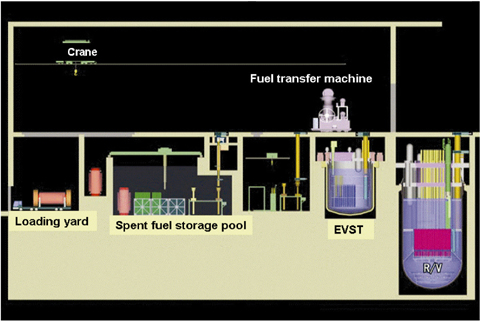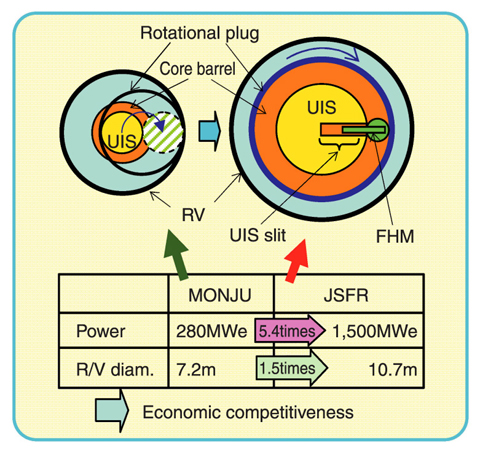
Fig.1-16 Fuel handling system of JSFR

Fig.1-17 Type of FHM and diameter of RV

Fig.1-18 UIS with slit and FHM
The fuel handling system for a sodium-cooled fast reactor (SFR) is required to allow remote handling, isolating the sodium from the air because the chemically active sodium surrounds the fuel. Reliable and safe fuel handling systems have been developed for "JOYO" and "MONJU".
The fuel handling system of the future commercial SFR (JAEA SFR; JSFR) studied in the FaCT project is composed of an in-vessel fuel handling machine, an outside-the-vessel fuel handling machine and, an outside-the-vessel fuel storage tank (EVST), etc. as in "MONJU" (Fig.1-16). However, in order to increase economic competitiveness further, we are now attempting simplification and size reduction of the fuel handling system through innovative technologies.
For the in-vessel fuel handling machine, we have been developing a new fuel handling machine (FHM) that is different from the ones in "JOYO" and "MONJU" and suitable for a compact reactor vessel (RV). In case of "MONJU" (280 MWe), its RV diameter is three times larger than that of the reactor core barrel, because the core upper internal structure (UIS) has to be displaced from its normal position right above the reactor core to the periphery when refueling. JSFR (1,500 MWe) has an FHM and UIS, and both of them are attached under the rotational plug the same as in "MONJU", but its UIS has a narrow slit space in which the fuel gripper unit of the FHM is able to move horizontally and approach any fuel assembly under the UIS by rotational movement, enabling refueling. In this design, the UIS need not be displaced widely when refueling. Therefore, a much larger RV diameter can be avoided in the design of JSFR, even with increase in the reactor output power up to 1,500 MWe (Fig.1-17).
However, as the size of the UIS's slit space is limited (width: 0.41m, height: 5.9m and depth: 2.6m), it is necessary to develop the FHM that can smoothly discharge and charge the fuel assembly at the specified position in this narrow space, meeting design requirements such as compactness, stiffness, and precise positioning (Fig.1-18). Based on the results of our design study, we are now planning to fabricate an FHM and perform a test to confirm its function.
In the R&D program for the fuel handling system, in addition to using R&D experience gained with "JOYO" and "MONJU" , we will acquire design data and confirm intended functions through mock-up tests and so on, especially for innovative designs and concepts. The results of these tests will be adequately reflected in the design study of the JSFR fuel handling system.